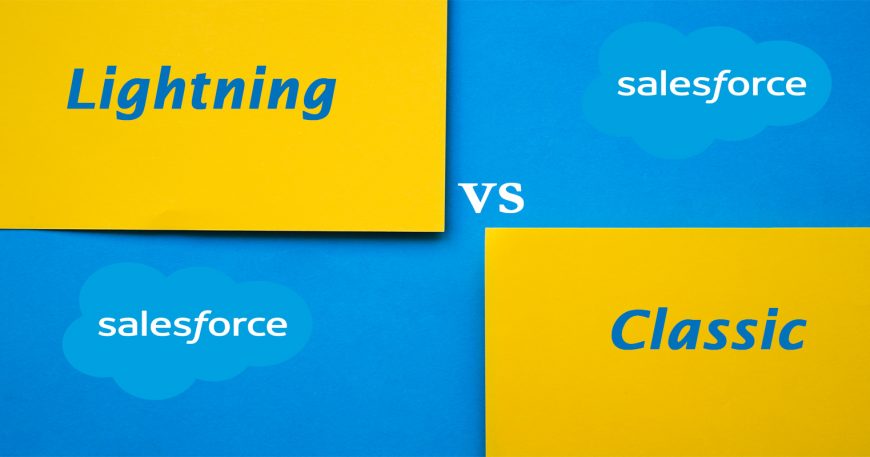Salesforce CRM is one of the leading customer relationship management solutions out there. With a focus on the ever-evolving need of the vendors and clients, Salesforce continues to innovate and provide new user experiences.
One of these new user experiences was the advent of Salesforce Lightning.
In 2016, Salesforce introduced an alternative User Interface (UI) to their Classic one, and since then, it has continued to address any shortcomings in Lightning. With every update, Salesforce Lightning comes with better and more comprehensive features to improve your customer service experience.
This leads to one of the key discussions about the Salesforce User Interface: should old users switch to Salesforce Lightning or continue with the Classic version? And are the new users missing out on anything by using Lightning as their default UI?
To determine the best, you need to explore a complete guide to all your UI related queries. Let’s dive in to determine the best approach to the Lightning vs Classic debate!
Salesforce Classic Overview
Salesforce Classic is the original User Interface that was initially introduced by Salesforce. It continues to be the infrastructure of choice for numerous companies and organizations. When it comes to Salesforce data, Classic comes with a comprehensive list of sales information ranging from accounts, campaigns, leads, and events, to service data such as assets, work orders, and cases.
In the Home features, Salesforce Classic includes customizable dashboards and homepage components, as well as the items to approve list. For Campaigns, Classic came with importing campaign members, managing their status updates, and adding members from reports.
Classic also has lead management features like lead conversion customization via the API and integrated emails and templates. As far as Salesforce Einstein is concerned, Classic has limited features like Einstein Forecasting and Einstein Discovery
Salesforce Services Offered by Rolustech
[wptb id=32056]
What’s New With Salesforce Lightning
Salesforce Lightning is the new and improved version of Salesforce Classic. In addition to most of the Classic features, Lightning brings several features of its own.
Better User Interface
The most striking feature that is registered immediately, is the superior User Interface. The homepage comes equipped with information like news on key accounts, key deals, and a performance chart. The interface is easier to navigate and accommodates more information with the help of tools and imagery, and lesser textual information.
Improves Sales Process
The sales process is improved by adding an activity timeline, displaying the progress of each lead. The path component guides users through the process of dealing with a lead. Additionally, the notes component allows for detailed notes making and note sharing in order to seamlessly translate ideas into reality.
Better Report Building
The Lightning Report Builder is a useful tool for summarizing records, analyzing Salesforce data, and improving report charts. With an interactive filter, users can easily view reports and get an accurate report analysis.
Einstein Integration
One very significant addition to Lightning is the Einstein Integration. Going beyond the basic AI functionalities in Salesforce Classic, Lightning includes automated, regular analytics updates. It also automates data preparation and modeling. Other features include the Einstein Bot Builder, Einstein Opportunity as well as Account Insights
Comparing The Lightning Experience With Salesforce Classic
By the sound of it, Lightning appears to be the superior User Interface. With several additional features, Lightning allows users to be well equipped when dealing with their customer relationship management. On top of that, the interface itself is easily navigable. Convenient tools such as the drag-and-drop functionality allow users to customize their interface without the need to develop code.
So why go with Lightning Classic at all?
The Classic version has some unique features that are yet to be incorporated into Lightning. Though the list is short, the Lightning version does not have custom Javascript buttons and certain apps from AppExchange are not supported. Apart from that, many old-school users of Lightning Classic prefer to use the familiar interface instead of having to migrate to Lightning.
The Hybrid Solution: Pros and Cons
Salesforce has a solution to this either-or question. The Salesforce users can switch between Lightning and Classic depending on what functionality they need. For those Sales and Services features present in Classic, but not in Lightning, users can toggle to Salesforce Classic. And when it comes to using the Lightning functionalities such as the drag and drop or the Einstein bot, users can switch back to Lightning.
This solution, however, does not come without its complications. Switching between Classic and Lightning can affect the underlying URL routing which, when resolved, can lead to some unexpected results. This can include broken bookmarks or email links.
How Can We Help?
By all predictions, Salesforce Lightning is set to become the preferred User Interface. Salesforce Classic can be considered a temporary interface, surviving until Lightning can compensate for the few shortcomings that remain. The best approach would be to roll out the Salesforce Lightning UI at your own pace. Rolustech offers the Salesforce Migration Services to allow older users to migrate to Salesforce Lightning at the pace of their choosing. The key to the migration approach is to take it slow, and Rolustech is there to help.
Rolustech also offers Salesforce Implementation Services to allow you to seamlessly transition from the Classic to Lightning UI. Our extensive CRM expertise will help you navigate your Salesforce CRM with efficiency as well as ease.
Rolustech is proud to be Salesforce Consulting Partners and Certified Experts. We have helped numerous firms with Salesforce Migration and Customization. Get in touch to learn more about the Salesforce platform and get a FREE Business Analysis.




